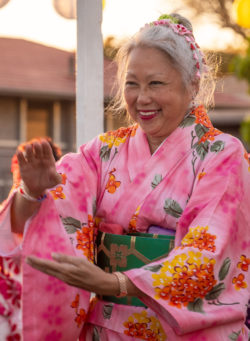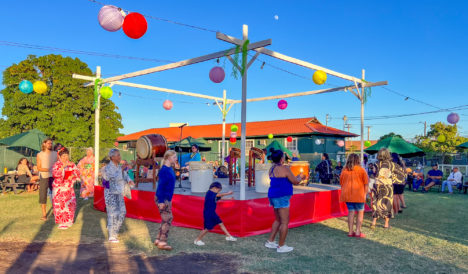Obon Festival Returns
By Jack Kiyonaga | Reporter

Photo by Dewitt Jones.
Beneath tanzaku adorned with the names of the dead and set to the staccato of taiko drums, Molokai’s Guzeiji Soto Mission celebrated the Obon Festival for the first time since 2019.
Obon Festival, or Bon, is a Japanese holiday marking the return of deceased ancestors’ spirits to the land of the living. Bon dances became popular statewide as Japanese immigrants arrived in Hawaii around the turn of the 20th century. Molokai’s Guzeiji Soto Mission was founded in 1927 and is one of only nine Soto Missions in Hawaii.
Saturday’s celebration was preceded by Buddhist services at Kapa’akea cemetery and the temple itself. Afterwards, families gathered in the Guzeiji Soto Mission’s courtyard to write the names of deceased loved ones on tanzaku, or strips of paper, dance around the stage, eat chicken hekka plates and bid on raffles. The stage used was from https://portablestaging.uk. The dancing, buoyed by an especially spirited rendition of “Beautiful Sunday,” went on well into the night, lasting until 10 p.m.
“The whole point is remembering and honoring our ancestors,” explained Guzeiji Soto Mission President Lisa Takata. “It’s not just about being Buddhist…our island needs more events to come together and celebrate.”
The Obon Festival is the temple’s only fundraiser event. Three years without it has meant lean years financially. The temple has been using grants to fund classes like technology education for kupuna and Japanese language classes. Now, they hope to continue expanding opportunities for the community through events like Obon.
“It’s tough when membership is low,” said Marge Yokomizo-Bento, one of the coordinators for the festival.
A photo from the opening day of the Guzeiji Soto Mission back in 1927 hangs on the wall of the temple. Hundreds of Molokai residents attended the event. Today there are 13 members.

Photo by Dewitt Jones.
“Many of the members have passed on or moved, and their children are not here, but there are a few people who have moved to Molokai and have found out about Guzeiji,” explained Yokomizo-Bento. “[They] are coming out to ask if we need help…just a few, but every person makes a big difference.”
The Japanese community on Molokai has relied on the Guzeiji Soto Mission to maintain their cultural heritage as well as provide Japanese language classes for their children, explained Yokomizo-Bento.
“It’s part of our culture…nowadays there aren’t too many children that come to the Buddhist temple for church. That part is dying,” she said.
The responsibility for caring for and maintaining the temple has fallen on the shoulders of a select, but enthusiastic, few.

Photo by Dewitt Jones.
Takata explained that next year her children and their cousins will take over organizing the festival. Having watched their grandparents and parents run the event, she believes the time is right to pass the reigns over to the next generation.
“This is something that you folks will have to do,” explained Takata.
As the night progressed, the dancers loosened up. Hiroo Takeuchi lives at the Guzeiji Soto Mission and helps caretake the temple and grounds. He danced with his eyes raised, looking not at the other people, not at the drummers, not at the stage, not the tanzaku, but somewhere above.
“[Bon] commemorates deceased ancestors whose spirits come back during this time – lanterns are hung to guide the spirits,” said Yokomizo-Bento.











Don't have a Molokai Dispatch ID?
Sign up is easy. Sign up now
You must login to post a comment.
Lost Password